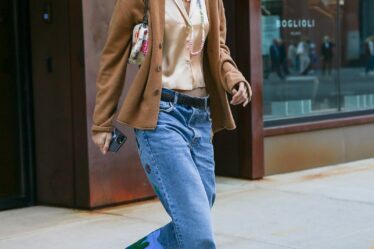NEW YORK — On a recent Thursday afternoon at Zara’s SoHo store, dozens of tourists and urban professionals shuffled along a checkout line that snaked halfway across the sales floor.
Upstairs, there was no line. Here, just two customers navigated a self-checkout station at a sleek, L-shaped white bar. Built into the bar are crates that automatically scanned their purchases and rang up the total on a screen above in a matter of seconds.
It wasn’t completely seamless. There were hiccups involving hangers and security tags. There were no instructions.
Even so, when asked if they’d use the self-checkout system again, the answer from both customers was a resounding yes. A little confusion about the security tag removal device, which only worked after the products were paid for, was a small price to pay for skipping the queue. “It was easy enough,” said one woman.
Self checkout has an image problem. Many consumers still associate the technology with clunky self-scanning kiosks at the grocery store. Walmart and Dollar General have scaled back their use of the technology in recent months, citing operational efficiency and theft prevention, respectively. Target is limiting its self-checkout lanes to 10 items or fewer. After a 2018 trial, Spanish fast-fashion retailer Mango decided against offering self-checkout.
The technology is slowly gaining traction in fashion. Fashion retailers like Zara and Uniqlo typically install sleek stations that allow shoppers to place items in a bin to be priced using radio frequency identification, sidestepping the dreaded barcode scanner. At Uniqlo’s SoHo flagship, self-checkout bins have completely replaced cashier-operated registers. The bins will eventually be installed in all of the retailer’s roughly 2,400 stores globally.
Champions of the technology say self-checkout can make stores operate more efficiently — where Uniqlo has installed them, machines have cut transaction times by half, according to Takahiro Tambara, chief information officer at Uniqlo-parent Fast Retailing. The machines also have the potential to reduce labour costs by eliminating the need for cashiers and even drive sales in high-traffic locations where long lines can deter purchases.
But rollout has been slow and retailers are being cautious about fully embracing the technology, which has also been associated with an increase in theft. Self-checkout equipment is also expensive to implement; the scan-less checkout systems that Uniqlo and Zara deploy require their entire supply chains to be RFID-tagged, an intensive process that takes upwards of six months.
While acceptance is growing, particularly among young consumers, many shoppers prefer interacting with human employees. A study from Drexel University published earlier this year in the Journal of Business Research found that traditional, cashier-operated checkout services make customers more loyal to the store.
And the concept may never be a good fit for many brands. High-end stores see relatively few transitions on any given day, making streamlined checkout a less-pressing issue. Many brands — and not just in the luxury space — also make high-touch, or human, service part of the value proposition.
“When you think of someone buying a $150 bag, it almost feels like self-checkout would cheapen the service,” said Matt Moorut, marketing analyst at Gartner. “Fashion has been one of the slowest areas to make changes in checkout.”
For now, Uniqlo’s all-in approach to self-checkout is an outlier. Zara’s dual-service approach is more likely to be widely adopted: self-checkout for customers in a rush, and traditional checkout for sceptics and shoppers craving a personal touch.
“We are far from a seamless and pure value-add level of self-checkout,” said Simeon Siegel, analyst at BMO Capital Markets. “Trial is key … It needs to add more value than discomfort.”
A Trial-and-Error Approach
For self-checkout to work, retailers have to experiment with what configuration best fits their needs. Uniqlo began piloting its RFID self-checkout solution more than a decade ago, and the most recent iteration of the concept launched in 2019.
“We continuously made tweaks based on our learnings, to evolve to where it is today,” said Tambara. “Our first design included a lid that had to be closed to accurately scan the RFID tags, but having to shut and open a lid was an inconvenience to customers, so we found a solution to eliminate it.”

Even today, Uniqlo’s self-checkout offering isn’t perfect; at the kiosks in its SoHo store, all the shopping bags are placed toward the end of the checkout section rather than in individual stations, causing some shoppers to walk over to the bags and then return to their station again to complete their transactions.
Every retailer has its own needs when it comes to self-checkout, said Moorut of Gartner, pointing to UK retailer Marks & Spencer, which in addition to self-checkout, offers self-service for in-store online returns and pickup.
Preventing ‘Shrink’
According to a 2023 survey conducted by LendingTree, an online loans marketplace, one in five respondents said they’ve accidentally taken items during self-checkout. One in seven admitted to stealing.
While RFID technology eliminates the tedium of scanning — and the opportunity for error or intentional skips — it hardly mitigates theft, analysts say. Zara’s RFID self-checkout stations equipped with security tag removal devices in fact might pose a heightened risk for shoplifting, said Siegel.
“It’s somewhat ironic the tag designed to specifically prevent theft can be removed by the potential thief,” he said. A number of retailers, including Uniqlo, don’t use security tags at all. Instead, a number of store associates are placed at the checkout stations for customer assistance, while other store personnel are dedicated to loss prevention, the company said.
But RFID could soon serve an anti-theft function, according to Spencer Hewett, founder and chief executive of Radar, a technology company that works with American Eagle and other major apparel retailers that already deploy RFID technology for real-time inventory visibility.
Radar’s RFID scanning sensors can detect when customers interact with and carry items throughout the store. When combined with cameras, this feature would be able to detect the exact number of products customers bring to the station so that if that doesn’t match the number of pieces rung up in the point-of-sales system, there will be a notification on the screen and store personnel would be alerted.
Radar is planning to launch its checkout function within the year.
For now, “self-checkout in fashion is still at a fairly immature stage,” said Moorut. “There are a lot of opportunities but also a lot of figuring out on the part of retailers before we get to a point where it’s driving massive benefits.”



